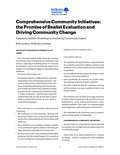The best way to address a shared challenge is to engage the people who are most affected by the issue to help develop solutions. Here at the Wellesley Institute we often speak about comprehensive community initiatives – but what does that really mean? This post taps into Bob Gardner’s insights during a recent Tamarack Institute workshop and strips back some of the layers around these initiatives.
According to Gardner, complex community initiatives “usually involve wide ranges of service providers, residents, advocates, governments and other stakeholders collaborating to develop comprehensive and integrated multi-level service and policy responses within specific communities,” although just like no community challenges are exactly alike nor are complex community initiatives.
This is an important point because it highlights the need for flexibility in response to community challenges. Just because something worked in one context doesn’t mean that it will work in another. The trick is to bring the right people to the table for a free and frank discussion and, crucially, to clearly articulate the challenge and identify targets and milestones for the response.
Part of articulating the challenge is acknowledging that solutions are never simple. Challenges incorporate multiple issues that are inter-related and interdependent – it is important that comprehensive community initiatives don’t focus on a single issue or assume that there is only one correct way to solve the problem. For instance, addressing a high diabetes incidence rate in a community may involve improving food security and increasing access to physical activity facilities and education campaigns and improving access to primary care and addressing barriers to access at local hospitals and considering how income insecurity affects the ability to receive the right medical treatment and so on. It is important to remember that one size does not fit all.
Gardner also highlights the need for comprehensive community initiatives to be genuinely community-based. This can include been rooted in a particular place but also it reflects the need for initiatives to truly reflect the voices of community members. Community empowerment and capacity-building should be the cornerstone of any comprehensive community initiative.
One of the benefits of starting with a deep community base is that community assets can be identified and supported. Coming from the outside with a particular problem in mind means that sometimes you can’t see the forest for the trees – it can be hard to see what is good about a community when you’re only focusing on the challenges. Community members are also ideally positioned to identify the drivers of change – these are the areas where you need to target your efforts to achieve maximum impact.
Finally, the nature of the solutions required to address complex challenges means that it is important to have a long horizon from the outset. No community is going to be able to solve poverty in 6 months, but by setting the right goals and milestones over a longer period real progress can be made. It is therefore important that time is taken to build up relationships to ensure that the initiative will last over the long-run. If community empowerment and capacity-building are your cornerstones the initiative should only get stronger and stronger over time.
Download Comprehensive Community Initiatives: the promise of realist evaluation and driving community change here.
Blog post by Steve Barnes. Steve is a policy analyst at the Wellesley Institue. You can reach him at steve@wellesleyinstitute.com.
